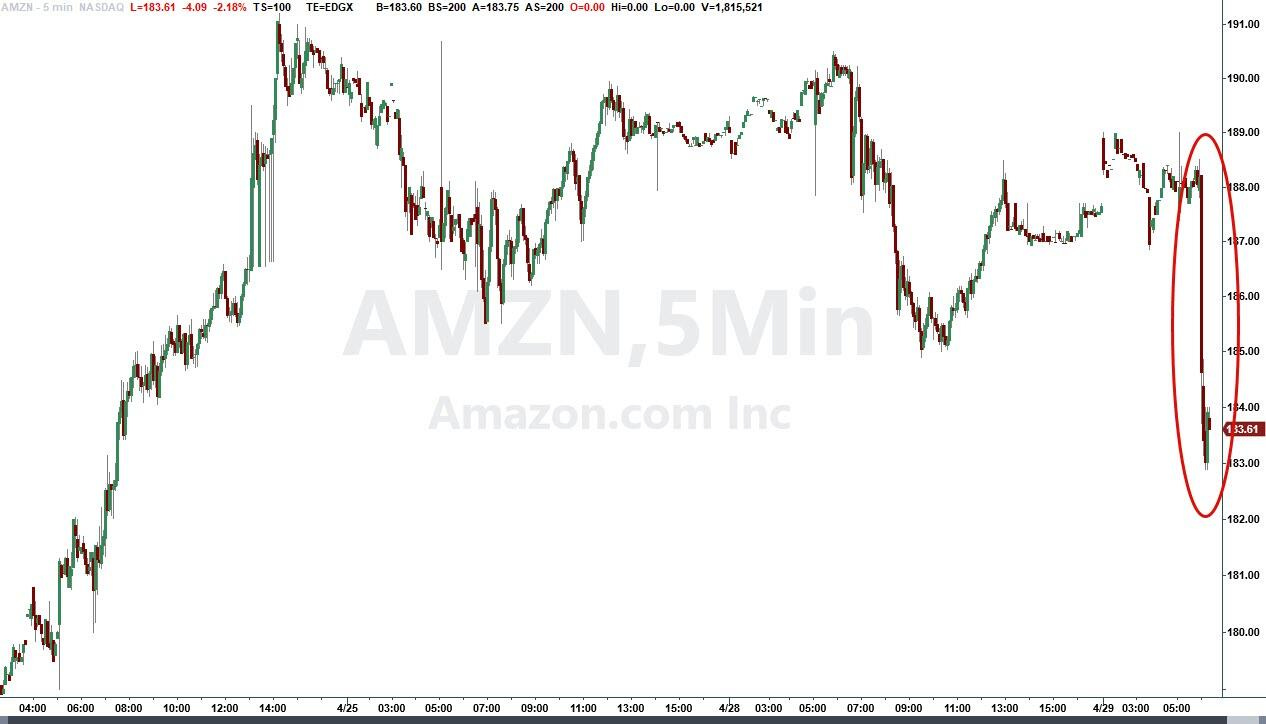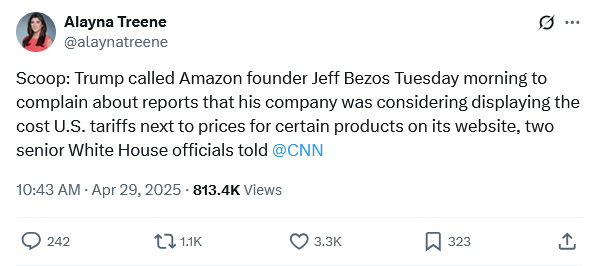The quiet part that rarely gets said about all White House press briefings is they are intentionally exercises in propaganda, not in providing information. The role of the Press Secretary is to present facts regarding a particular issue in a narrative which is favorable to the White House and the current Administration.
The White House press corps saw White House Press Secretary Karoline Leavitt doing exactly that with gusto yesterday, when she pushed back hard against a report that Amazon was reportedly planning to display the presumed “additional cost” brought on by the Liberation Day tariffs.
Punchbowl News first reported that Amazon will soon “display how much of an item’s cost is derived from tariffs — right next to the product’s total listed price.” The move could directly illustrate to American consumers how Trump’s tariffs are affecting the cost of goods. Trump has slapped 145% tariffs on imports from China and a 10% minimum tax on all other countries.
Leavitt did not flinch nor did she hesitate. She lost no time in denouncing Amazon’s plans as a “hostile and political” act.
What unfolded throughout the remainder of the morning quickly became an exercise in which the political spin—very much the propaganda of the Trump Administration—became a prevailing reality, forcing Amazon to backtrack rather hurriedly.
Tracing that trajectory is an illuminating exercise highlighting both the mechanics of spin—of framing facts with a particular narrative—and how spin can determine which narrative prevails in any communications contest.
Contents:
The Announcement And The Pushback
To understand how this story evolved throughout yesterday morning, we should begin with the start of the narrative, which is the question in yesterday’s White House Press Briefing and Press Secretary Karoline Leavitt’s strongly worded response.
[Reporter] So it was reported this morning that Amazon will soon display a little number next to the price of each product that shows how much the Trump tariffs are adding to the cost of each product. So isn't that a perfect, crystal-clear demonstration that it's the American consumer and not China who is going to have to pay for these policies?
[Press Secretary] I will take this since I just got off the phone with the President about Amazon's announcement. This is a hostile and political act by Amazon. Why did Amazon do this when the Biden administration hiked inflation to the highest level in 40 years?
And I would also add that it's not a surprise because, as Reuters recently wrote, Amazon has partnered with a Chinese propaganda arm. So this is another reason why Americans should buy American.It's another reason why we are on-shoring critical supply chains here at home to shore up our own critical supply chain and boost our own manufacturing here.
The question referred to a report that appeared on Punchbowl News that Amazon was planning a modification to their pricing displays that showed how much of a product’s price was directly attributable to the Liberation Day tariffs and subsequent trade war tariffs with China.
Was the reported app change contemplated by Amazon intended to be overtly “hostile and political”? That we really do not know. Based on Amazon’s subsequent statement, there is a presumption to be made that there no political overtones intended. Any inference in either direction in that regard is purely speculative.
However, regardless of whether the proposed pricing change was “political”, there is no denying that it was very directly politicized by the reporter’s question. No matter Amazon’s actual intent, when the reporter asked the question in the press briefing he established a framing that struck directly at President Trump’s tariff and trade policies. Even if Amazon had the most pristine motives in the world, once that question was asked, the proposed pricing change was laden with political baggage.
As a politicized message, the pricing meter would have undeniably been “hostile” to the President’s tariff and trade policies, simply by putting a supposed price tag on the tariffs.
We can also see, therefore, the operative logic behind Karoline Leavitt’s very assertive response.
Reframing The Message
There are two points about that response in particular which warrant mentioning.
First, although the reporter actually directed at both Treasury Secretary Scott Bessent and Karoline Leavitt, Ms. Leavitt was quick to pull the question to her by stating that she had “just got off the phone with the President about Amazon's announcement.” Making that statement quickly established several things: 1) she knew the question would come up and had taken care to get specific commentary from President Trump on the matter; 2) she was willing to lean into the political overtones of the question; and 3) as Press Secretary, the briefing room is very much her domain—Treasury Secretary Bessent might have been there to provide expert answers on trade questions, but all other questions were hers to deal with no matter what.
Second, by doubling down on the political aspect, calling the pricing change “hostile and political”, she completed what the reporter began, making the pricing change a political statement, no matter what was initially intended. As a political statement, the pricing change immediately became radioactive for Amazon. As a political statement, it becomes fair game for pushback and criticism.
Whether Amazon’s proposed pricing change was “political” or merely “politicized”, by moving the change into a realm of political rhetoric, Karoline Leavitt reframed the issue to one of possible political messaging by Amazon.
Ms. Leavitt pushed the reframing by rhetorically asking about other potential political messages Amazon could have asserted with their pricing displays in the past but didn’t. Within the context of political messaging, the question about why Amazon did not showcase the impact of the 2022 hyperinflation cycle on prices in a similar fashion is relevant—why send a particular message and not another message?
Thus Leavitt’s response was to the proposed price display change as a political message opposing the Liberation Day tariffs and the subsequent trade war tariffs on China. Regardless of whether Amazon intended to send such a message, she capitalized on the reporter’s application of the pricing change to further a political narrative the media wished to assert—that the tariffs constituted a direct economic harm to American consumers—to construct an inference that Amazon was taking a political stance against the tariffs when it had not taken a similar stance against other forces which acted to push up prices.
Karoline Leavitt then proceeded to undercut the inferred political stance by referencing a 2021 Reuters report that Amazon had intentionally partnered with part of the Chinese Communist Party’s propaganda apparatus in order to advance its business operations in China.
In a core element of this strategy, the internal document and interviews show, Amazon partnered with an arm of China's propaganda apparatus to create a selling portal, opens new tab on the company's U.S. site, Amazon.com – a project that came to be known as China Books. The venture – which eventually offered more than 90,000 publications for sale – hasn't generated significant revenue. But the document shows that it was seen by Amazon as crucial to winning support in China as the company grew its Kindle electronic-book device, cloud-computing and e-commerce businesses.
While she clearly exaggerated the currency of that report by characterizing it a “recent”, the existence of the report itself is an undeniable fact, and places Amazon in the position of intentionally working to further Chinese propaganda as part of its business strategy.
If Amazon is willing to further Chinese propaganda as a business stratagem, and is making political statements with its pricing displays, how much credibility should be accorded those pricing displays?
Karoline Leavitt of course does not answer that question, but she does not need to. Leaving the question hanging in the minds of reporters is far more impactful than any answer she might provide, for each reporter then must answer the question using their own imagination. That gives the question a life of its own no matter how any reporter chooses to process the it internally.
Alternative Media Amplifies The Message
Politics in media invariably becomes a question of what is good for the goose becomes good for the gander. As the corporate media was quite willing to seize on the reported Amazon pricing display change to push a political narrative of the tariffs harming American consumers, the alternative media was equally willing to foster a political narrative of Amazon taking sides in the trade war with China against the United States.
Nick Sortor, an independent alt-media journalist, tweeted out his admiration of Karoline Leavitt’s pushback on the Amazon pricing move:
Sean Davis, co-founder of The Federalist, tweeted this observation.
Alternative media outlet ZeroHedge highlighted Amazon’s 2% stock drop in premarket trading.
Shares of Amazon tumbled to premarket lows Tuesday after White House Press Secretary Karoline Leavitt called the company's recent decision to display the effect of tariffs on products a "hostile and political act," adding "why didn't Amazon do this when the Biden administration hiked inflation to the highest level in 40 years?"
Another alternative media outlet Breitbart covered the proposed pricing change by highlighting a tweet by Trump Administration Special Envoy Richard Grenell
This is the power of effective re-framing in an age of highly partisan media. Corporate media might be decidedly “anti-Trump”, but there is a significant segment of alternative media outlets and independent journalists who are unashamedly pro-Trump, a reality that corporate media is loathe to admit.
Such outlets are only too willing to take a message such as what Karoline Leavitt provided and amplify it across their respective social media followings and readerships.
Remember, the job of a White House Press Secretary is to present facts surrounding various issues and events in such a way that reflects favorably on the President. When the Press Secretary provides a messaging that is easily amplified by “friendly” media outlets, that is a job well done no matter who is in the Oval Office.
Amazon Retreats
Given the instant politicization of the reported pricing change that occurred within yesterday’s White House Press Briefing—and possibly after seeing the premarket share price drop—Amazon quite predictably shied away from anything that might have a political context, and sought to deny the original report.
Amazon (AMZN.O), said Tuesday it never considered listing tariffs on its main retail site and nothing was implemented on any company site. "The team that runs our ultra low cost Amazon Haul store has considered the idea of listing import charges on certain products," a company spokesperson said.
Amazon’s apparent about-face left many of the original critics of the proposed price display change unimpressed.
Amazon shot itself in the face Tuesday with the hyper-partisan decision to show its customers how much tariffs have increased the costs of a particular product.
ZeroHedge was cynically terse and caustic on the narrative change.
CNN White House Reporter Alayna Treene tweeted that Amazon backtracked after President Trump reached out to Jeff Bezos directly.
Whether Amazon responded to media pressure from the growing cadre of independent journalists and alternative media outlets whose reach in many cases surpasses that of the corporate media or to political pressure from the White House is perhaps ultimately not that relevant. By mid-morning, Amazon was walking the story back as fast as it could.
Was It Political?
While Karoline Leavitt’s pushback against the proposed price display change was undeniably effective, left unanswered is the question of whether or not the display change was intended to be a political message.
Absent a clear statement by Amazon to put the change in a political context, there is no way to definitively answer that question. However, while we cannot be certain about Amazon’s political motivations, we can be certain about Amazon’s marketing motivations.
Amazon wants to be able to raise prices, and wants to avoid any negative publicity when it does raise prices. Blaming price increases on the Liberation Day tariffs is a way for Amazon to raise prices and minimize negative publicity.
The substantive problem with this tactic is that singling out any one price factor in such fashion is inherently deceptive and not a little disingenuous. Blaming tariffs for price rises might be an effective marketing tactic, but it is not an entirely honest one.
We should not lose site of the historical reality that President Trump’s tariffs from his first term did not result in significant inflation.
While any tariff is an upward pressure on prices, the necessary caveat of all else being equal is invariably a falsehood. In the real world all else is never equal. There are always multiple pricing forces pushing consumer prices both up and down.
We had an example of that last month, when the Consumer Price Index printed deflation for the first time in months.
March factory gate prices even set the stage for further price easing, absent any changes in the economic environment (i.e., “all else being equal”).
With the clear existence of pricing forces which are leading to lower prices, it is a stretch to presume that any price rises observed will be equal to tariffs paid when goods are imported.
We should note that even Wall Street does not believe that to be the case, which is why in the days following the initial “Liberation Day” announcements, the stock market was all over the place.
Political subtexts aside, marketing benefit to Amazon of breaking out the “cost” of tariffs separately is that accountability for price increases is deflected towards the tariffs.
The tariffs get the blame for the price increases, not Amazon. By extension, President Trump gets the blame for price increases, not Amazon.
It’s not Amazon raising prices, but President Trump because of his tariffs—or so the implied messaging inherent in this tactic suggests.
Only it is Amazon raising prices. It can only be Amazon rising prices. Regardless of why any vendor raises prices, it is always a vendor’s choice to raise prices. It is always the vendor’s choice of what amount to raise prices. Every price hike is the result of a vendor choice.
Because the vendor is always the one raising the price—because Amazon is the one raising the price—how can we be sure that Amazon’s reported “tariff cost” is accurate? How can we know that it has not been “padded”, taking advantage of a politically charged situation to push prices artificially higher?
The short answer is that we can’t.
Politics aside, in economic terms such a pricing display is ironically a less accurate and less complete pricing message than just simply stating the purchase price.
When only the purchase price is stated, the prospective buyer is told that the sum of all pricing forces up and down, including the seller’s profit motive, resolves to the price shown. The buyer does not know the individual magnitudes of the pricing forces involved, but the buyer does not need to know that if the buyer knows the final price.
When the “tariff cost” is broken out separately, the buyer is being told the magnitude of only one of the pricing forces. Subtextually, the buyer is also being told that one pricing force is responsible for 100% of whatever price increase is shown.
Because there are a myriad of pricing forces, such a message is simply not accurate.
Regardless of motivation, Amazon’s intention behind the prospective display change was to maximize its ability to raise prices by blaming the tariffs. By calling future price increases “tariff costs”, Amazon could push the blame for those price increases onto the tariffs, and onto President Trump as the source of the tariffs.
For obvious reasons, the White House had an interest in thwarting Amazon’s effort.
Amazon’s effort failed spectacularly. The White House succeeded in thwarting that effort.
Amazon’s effort failed and the White House succeeded in part because the White House Press Secretary seized control of the messaging. Instead of allowing Amazon to drive its messaging with its narrative, Karoline Leavitt flexed the White House’ messaging muscles to push a different narrative and a different message, one which did not reflect well on Amazon at all.
This is the job of any White House Press Secretary, serving in any Presidential Administration. This is what any White House Press Secretary does.
This is an instance of Karoline Leavitt doing the job of White House Press Secretary extremely well and with great success.
We do well to recognize this, because to do so is to look past the narrative and drill into the facts which lie beneath every narrative. That is where real understanding of any issue will always be found—in the facts, not in the narrative.
















I must say that I had no problem with Amazon displaying tariff costs for their imported products, PROVIDED they also displayed foreign tariff costs for their domestically produced products. Doing both is not politicization, doing just one is.
I’m just glad Amazon is highlighting “Small Business Owners.” I almost always purchase from them, and they all make their products in the good ole’ US of A.